Part of a series of articles titled Volcano Types.
Previous: Summit Calderas
Next: Older Caldera Complexes
Article
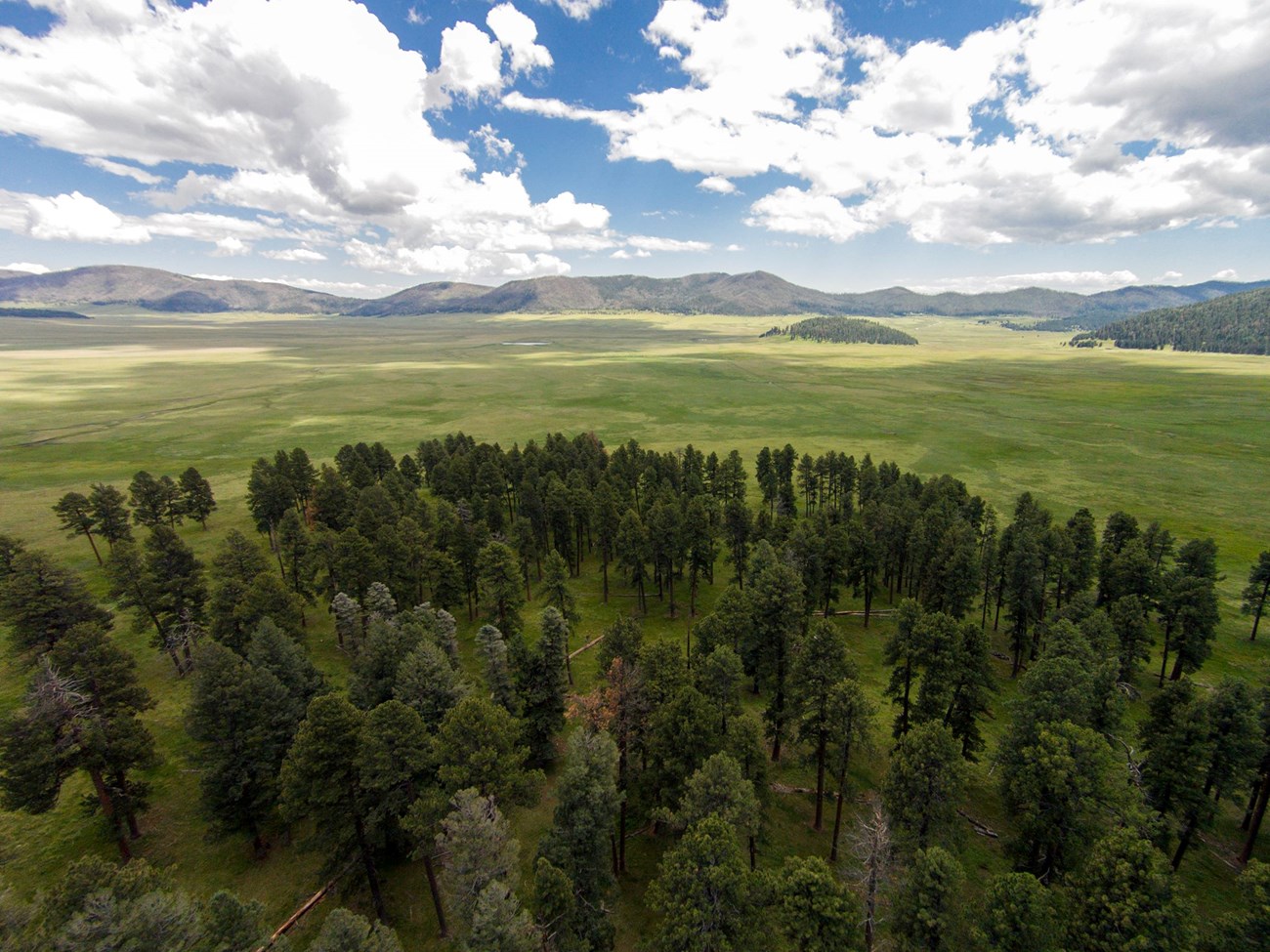
NPS photo.
Resurgent calderas are the largest volcanic features on Earth. But they are not soaring mountains like composite volcanoes, nor hulking masses like shield volcanoes. They form by ground subsidence after especially large volcanic eruptions that partially empty the underlying magma reservoir causing its roof to collapse.
This type of caldera is truly immense and with diameters that can reach many tens of miles (kms) across. They erupt massive volumes of ash and pumice in eruptive columns that reach into the stratosphere. Ash from these eruptions is carried by winds across the globe. Caldera collapse is accompanied by the eruption of pyroclastic flows that cover huge areas both inside and outside the caldera walls.
The presence of resurgent domes are a defining feature of resurgent calderas. These uplifted areas form after caldera collapse when the ground surface is pushed up due to magma movement within the magma chamber. Resurgent domes are distinct from lava domes as they are uplift features, and not the products of volcanic eruptions themselves.
Resurgent calderas are marked by broad volcanic depressions ringed by low steep cliffs or hills that represent the walls of the caldera. Their floors may be relatively flat, particularly in areas where there are sediments from lakes that formed within the collapse basin. The interior of these calderas include resurgent domes and the products of post-caldera volcanism, which are typically either lava flows or lava domes.
The largest resurgent calderas such as Yellowstone are sometimes referred to as "supervolcanoes", especially in popular culture. While the term is used by some geologists to refer to volcanoes that have experienced eruptions of the greatest magnitude and intensity (e.g., ones with the value of 8 on the Volcanic Explosivity Index (VEI)), other geologists prefer to describe these volcanoes as having experienced super eruptions because caldera systems also have eruptions of varying magnitudes during their lifespans, and VEI 8 eruptions are quite rare in the geologic record.
Precaldera volcanism is generally distinct from the activity that leads to caldera collapse as it is typically of smaller volume, includes eruption of a wide range of compositions, and may include the construction of volcanic edifices like lava domes, cinder cones, or even composite volcanoes.
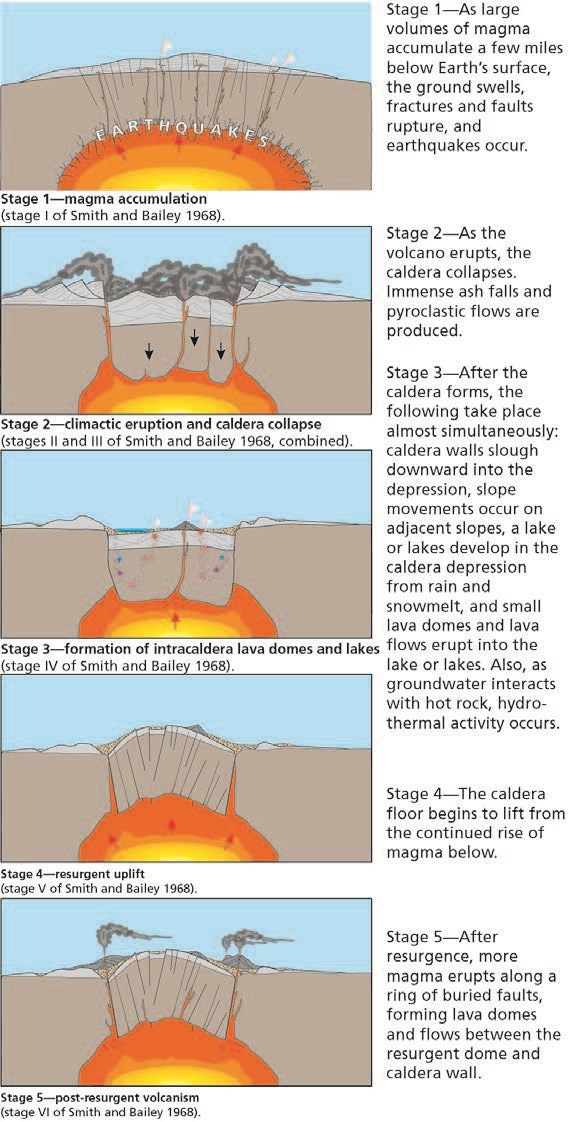
The caldera-forming eruption cycle includes five stages:
Stage 1: The accumulation of large volumes of silicic magma in the shallow subsurface, leading to uplift and faulting.
Stage 2: Eruption of large volumes of magma from ring fractures generates a massive eruption column that produces widespread pumice-fall and ash-fall deposits and produces thick pyroclastic flows that can cover large areas in and around the caldera. Collapse occurs as a result of the emptying of parts of the magma chamber.
Stage 3: Mass movements widen the caldera as unstable slopes fail. Lakes may fill or partially fill the depression that resulted from collapse. Post-caldera small-volume eruptions of lava domes or flows ensues.
Stage 4: Resurgence (uplift) begins due to the movement of magma in the shallow magma reservoir.
Stage 5: Eruptions along the ring fracture emit lava flows or build lava domes.
Graphic (right) by Trista Thornberry-Ehrlich (Colorado State University) after Smith and Bailey (1968).
[Smith, R. L., and R. A. Bailey. 1968. Resurgent cauldrons. Pages 613–662 in R. R. Coats, R. L. Hay, and C. A. Anderson, editors. Studies in volcanology: a memoir in honor of Howel Williams. Memoir 116. Geological Society of America, Boulder, Colorado.]
Valles Caldera National Preserve and Yellowstone National Park contain resurgent calderas. Bandelier National Monument is adjacent to Valles Caldera National Preserve and contains extensive ash-flow tuffs (ignimbrites) and fall deposits from Valles’ caldera-forming eruptions.
Several additional national park areas are in or near older caldera complexes, the most of which were likely resurgent calderas.
Valles Caldera is the type example for resurgent calderas meaning that it is considered to be the best example of this volcanic landform. Extensive studies of the Valles Caldera since the 1960s have been essential for understanding the origin and eruption dynamics of this type of volcanic center.
The Valles Caldera is nearly 14-mi (22 km) in diameter. Its resurgent dome, Redondo Peak, is approximately 3,300 ft (1,000 m) higher than the caldera floor and reaches an elevation of 11,258 ft (3,431 m). The Valles Caldera is located in the Jemez Mountains of north-central New Mexico and is adjacent to the Rio Grande Rift.
Two separate calderas are present in the Jemez Mountains:
Toledo Caldera: formed 1.6 million years ago. It is located to the northeast of the Valles Caldera. Much of this caldera is outside the preserve boundary.
Valles Caldera: formed 1.24 million years ago. Most of the topographic features in Valles Caldera NPres, including the caldera walls, Valle Grande, postcaldera lava domes, and Redondo Peak (the resurgent dome) relate to the Valles eruption.
The Bandelier Tuff contains ash-flow and tephra-fall deposits from both caldera-forming eruptions, as well as pyroclastic deposits from a pre-caldera eruption at 1.85 million years ago.
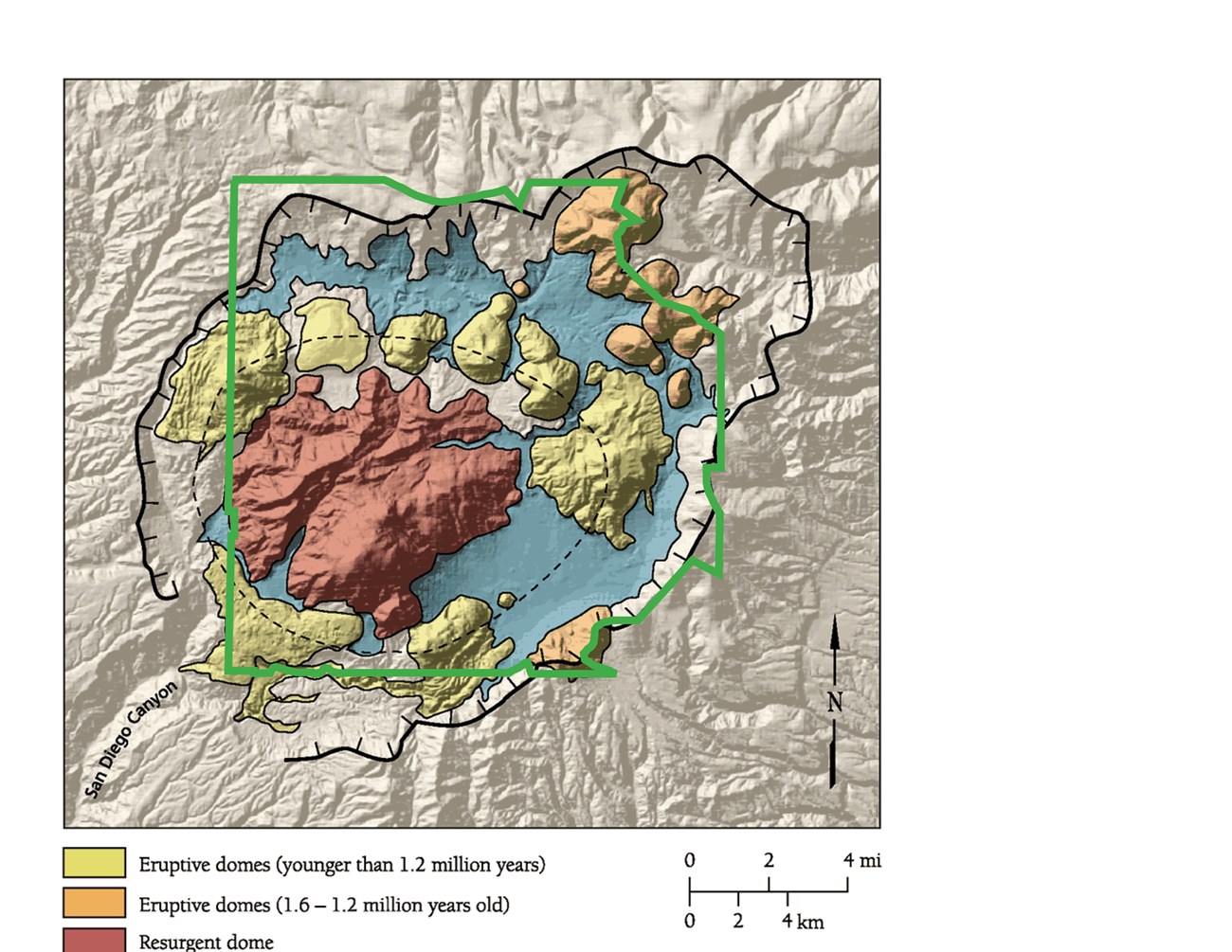
Image courtesy of New Mexico Bureau of Geology and Mineral Resources,
Bandelier National Monument is adjacent to the southeast flank of the Valles Caldera and contains volcanic rocks erupted during the climactic eruption. The Bandelier Tuff, the main rock unit found in the park, consists of extensive ash-fall and pyroclastic-flow deposits from the eruptions of the Toledo and Valles calderas.
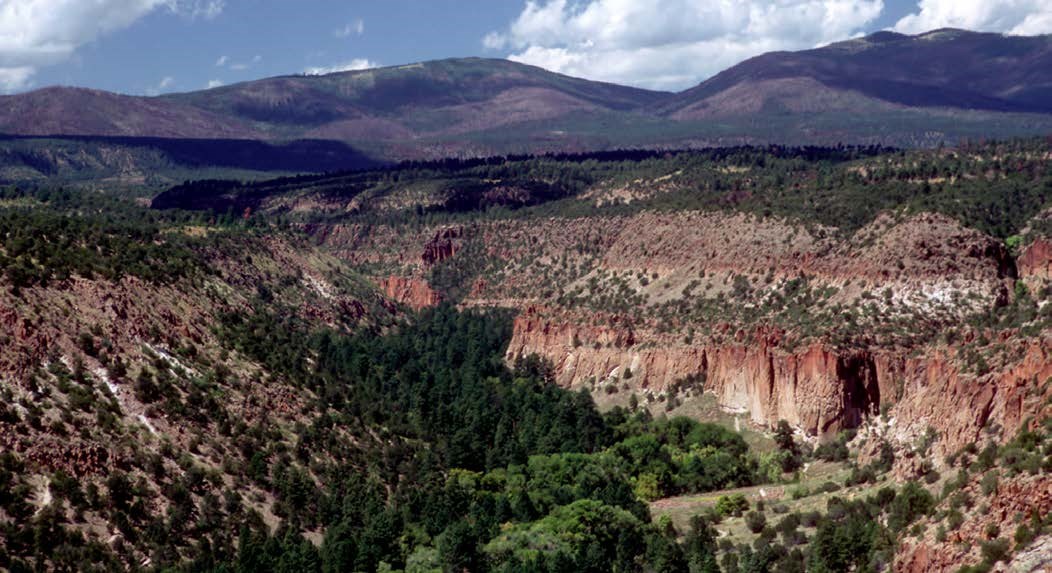
NPS photo.
The Yellowstone Plateau, a landscape heralded by steaming geyser basins, cliffs of obsidian, and a rich abundance of wildlife, is also the site of some of the largest eruptions that have occurred in geologic history.
The region in and around Yellowstone National Park has seen three different caldera-forming eruptions during the Pleistocene:
First Caldera (Island Park Caldera or Huckleberry Ridge Tuff Caldera): formed 2.1 million years ago. This is the largest of the calderas on the Yellowstone Plateau with a diameter of 53 by 28 mi (85 by 50 km) and an erupted volume of 590 cubic miles (2,450 cubic km).
Second Caldera (Henry’s Fork Caldera): formed 1.3 million years ago. This is the smallest caldera on the Yellowstone Plateau with a diameter of 10 mi (16 km) and erupted volume of 67 cubic miles (280 cubic km).
Third Caldera (Yellowstone Caldera): formed 640,000 years ago. This the most recent of the calderas on the Yellowstone Plateau. It has a diameter of 53 by 28 mi (85 by 45 km) and an erupted volume of 240 cubic mi (1,000 cubic km).
Large volume silicic tuffs are associated with each of the caldera-forming eruptions. The 2.1 million year old Huckleberry Ridge Tuff covers an area of approximately 6,000 square miles (15,500 sq km). The Mesa Falls Tuff is associated with the Henry’s Fork Caldera and the Lava Creek Tuff is associated with the Yellowstone Caldera. Each of these tuffs contain both ash-fall and pyroclastic flow deposits.

Adapted with permission from Windows into the Earth by Robert Smith and Lee J. Siegel, 2000.
A resurgent caldera volcanic center erupts a variety of compositions throughout its eruptive history, including pre- and post- caldera-collapse volcanism. During the climactic eruptions when collapse occurs, silicic magmas are erupted.
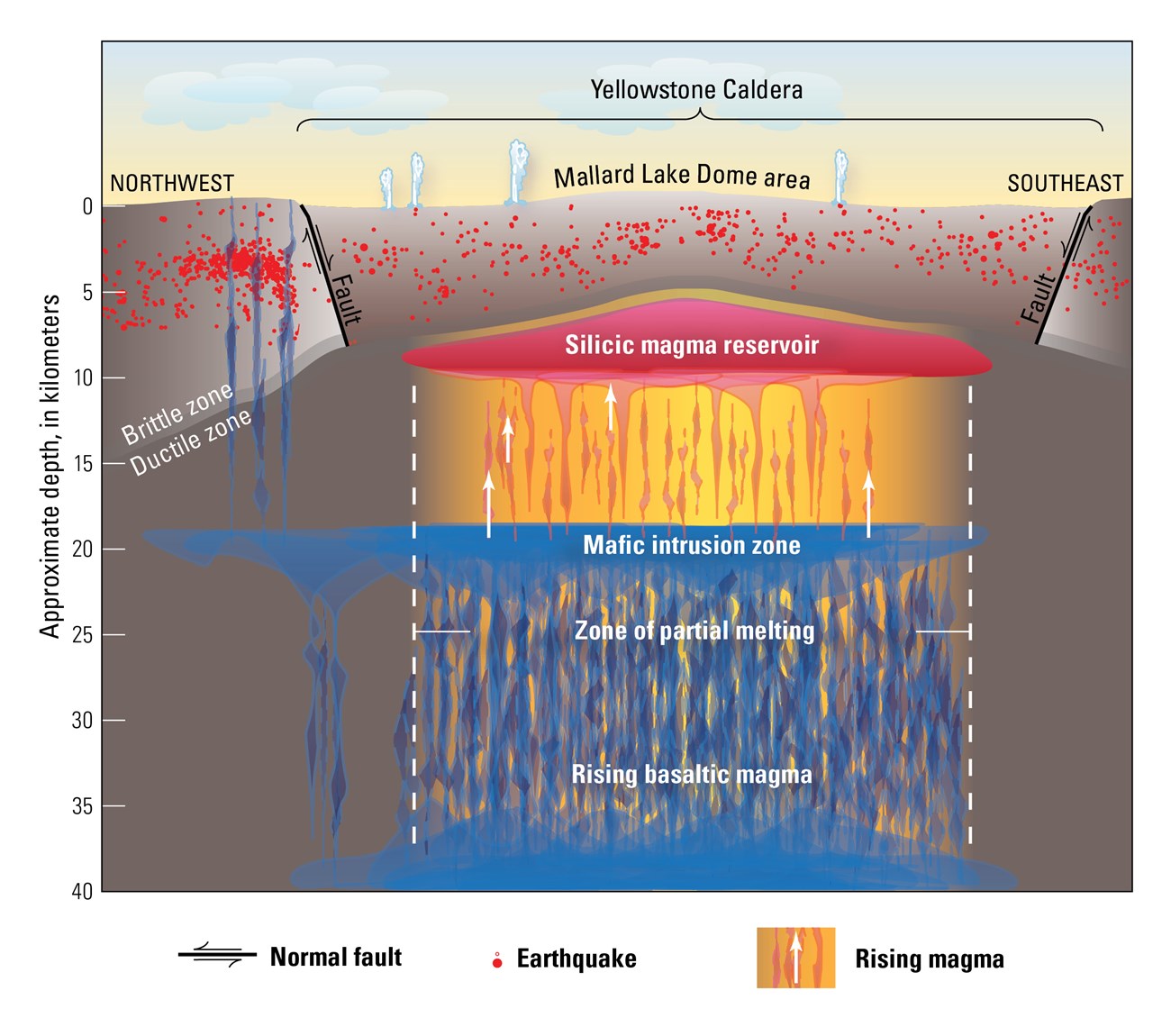
Modified from USGS graphic.
Caldera-forming eruptions are usually Ultra-Plinean with Volcanic Explosivity Index (VEI) value of 7 (Mega-colossal) to 8 (Apocalpytic).
Resurgent calderas occur in continental settings. The Yellowstone Caldera is located above the Yellowstone mantle plume (continental hot spot), and the Valles Caldera is located next to the Rio Grande Rift.
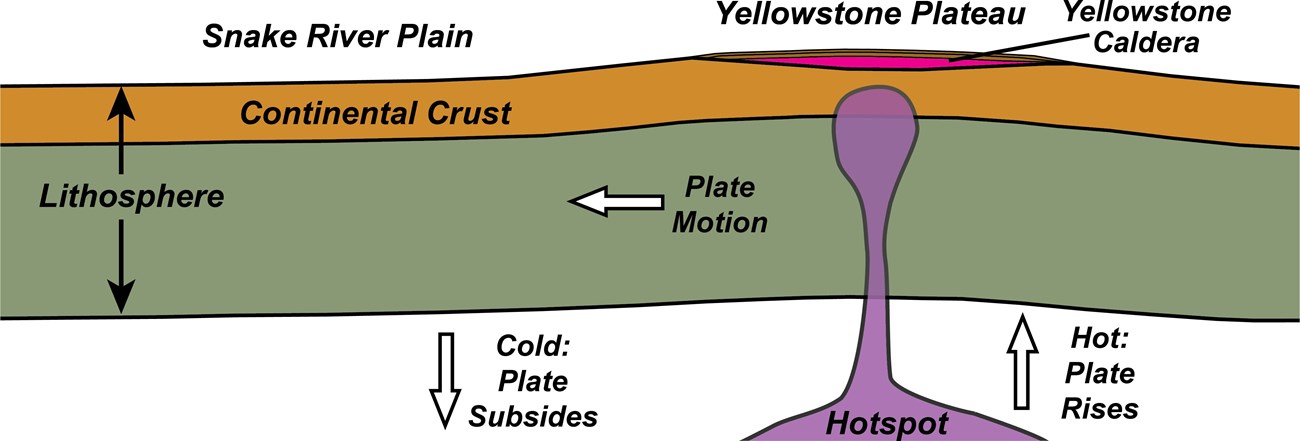
Modified from “Beauty from the Beast: Plate Tectonics and the Landscapes of the Pacific Northwest,” by Robert J. Lillie, Wells Creek Publishers, 92 pp., 2015.
Resurgent calderas are much larger than that of any preexisting volcanic edifice, although they occur in regions that have experienced previous volcanism. Caldera-forming eruptions occur along ring-fractures. Calderas are widened by landslides and other mass-wasting events because their steep slopes are unstable.
The caldera walls at the Jemez Caldera rise approximately 1,650 ft (500 m) above the floor.
Lava flows or lava domes from postcaldera eruptions as well as resurgent domes are present inside calderas. Many resurgent calderas also have extensive hydrothermal features, most notably at Yellowstone National Park.
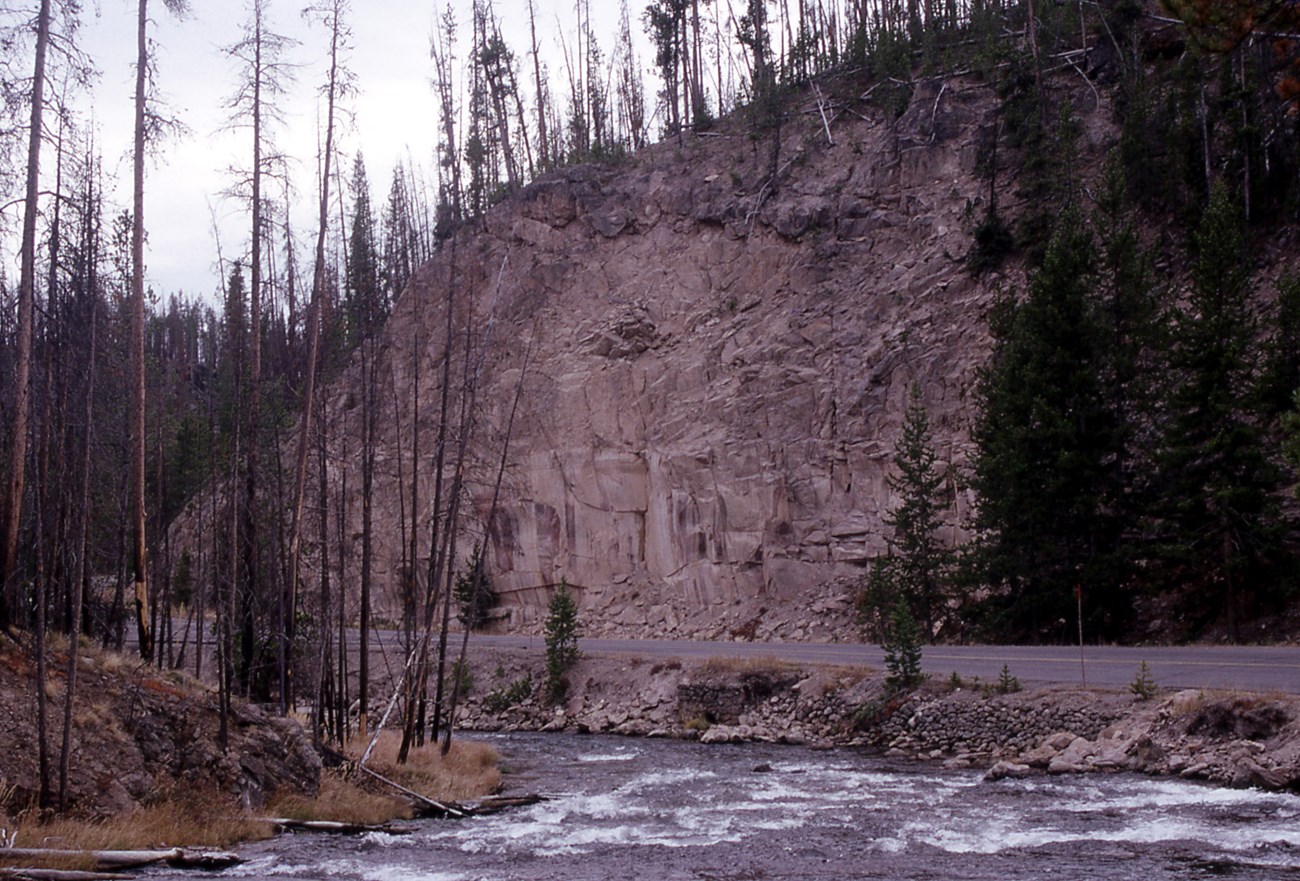
NPS by Jim Peaco.
Resurgent domes are an uplifted region within the center of the caldera due to magma upwelling in the underlying magma reservoir. Redondo Peak is the resurgent dome in the Valles Caldera. Two resurgent domes, Sour Creek and Mallard Lakes, are found in Yellowstone NP. Each have gently sloping flanks and are cut by multiple faults that formed during uplift.
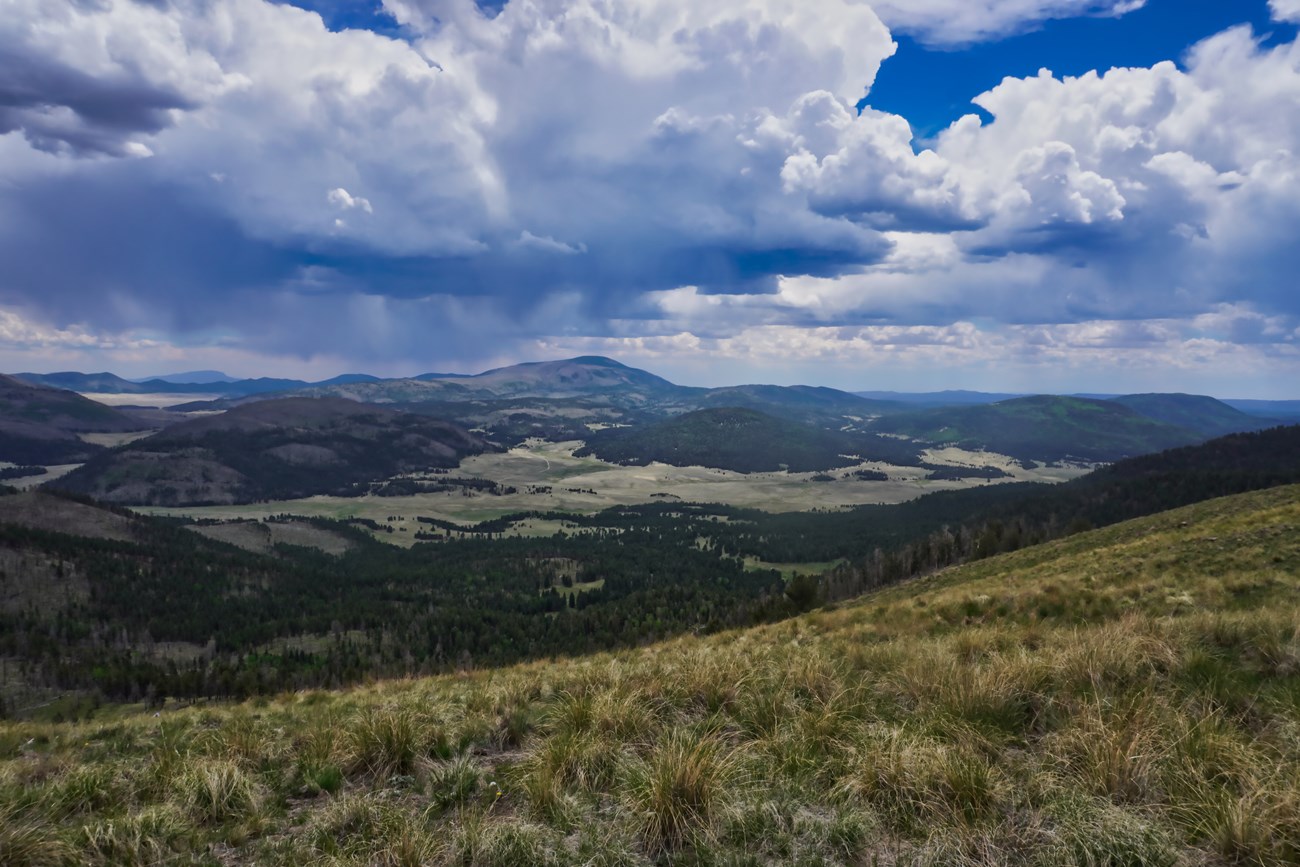
The eruption of lava domes is a characteristic of post-caldera volcanism. Several post-caldera lava domes are aligned on the ring fracture in the Valles Caldera.
The Yellowstone Plateau experienced eruptions of voluminous lava flows following the eruption of the Yellowstone Caldera 640,000 years ago.
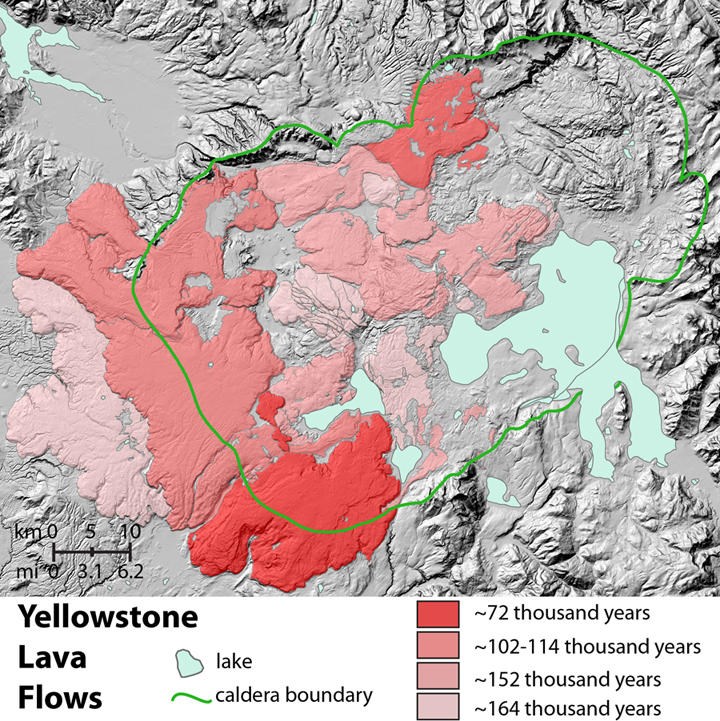
USGS graphic.
Caldera-forming eruptions emit large-volume pyroclastic flows that travel as density currents of superheated volcanic gases, ash, pumice, and rock fragments that travel along the ground and can even surmount ridges. They are erupted from ring fractures and can travel many tens of miles (km) from their vents and completely fill valleys. These VEI 7 to 8 eruptions generally have multiple phases that may be separated by years or decades. For example, the Huckleberry Ridge Tuff erupted from the Yellowstone Caldera contains three ignimbrite units that cooled or partially cooled before subsequent phases of the eruption.
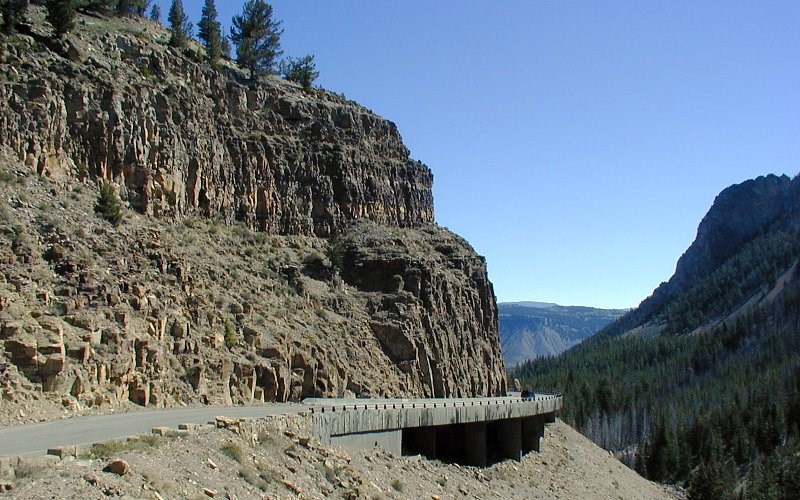
USGS image by Steve R. Brantley.
The VEI 7 and 8 eruptions that form resurgent calderas emit massive quantities of ash and pumice in their eruption columns which produce widespread fall deposits. Fall deposits usually show stratification (layering) and are sorted by size.

Photo by Madison Myers, Montana State University.

. USGS graphic.
The large magma chambers underneath resurgent calderas provide heat for extensive hydrothermal systems, although the hydrothermal systems are much shallower than the underlying magma chambers.
Yellowstone contains more than 10,000 hydrothermal features, including more than 500 geysers.


Left image
Map of yellowstone area.
Credit: Modified from USGS graphic.
Right image
Hydrothermal features in Yellowstone National Park. Different types of hydrothermal fluids produce the variation in the types of features present.
Credit: Modified from USGS graphic.
Calderas present both proximal and distal volcanic hazards. Post-caldera volcanism may consist of effusive or explosive eruptions, and include magmatic eruptions and phreatomagmatic eruptions.
Proximal volcanic hazards include ash clouds, ash and tephra fall, pyroclastic flows and surges, landslides, fumaroles, and earthquakes. Distal hazards include ash clouds, and ash and tephra.
Both Yellowstone and Valles calderas have active geothermal areas that present geohazards.
Valles Caldera National Preserve (VALL), New Mexico—[VALL Geodiversity Atlas] [VALL Park Home] [VALL npshistory.com]
Yellowstone National Park (YELL), Wyoming—[YELL Geodiversity Atlas] [YELL Park Home] [YELL npshistory.com]
Part of a series of articles titled Volcano Types.
Previous: Summit Calderas
Next: Older Caldera Complexes
Last updated: April 17, 2023